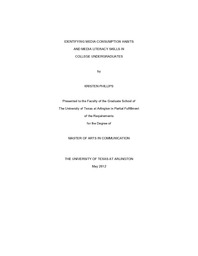| dc.description.abstract | In the United States, media literacy education is not as advanced as in other English speaking regions such as, Great Britain, Canada, and Australia. Most teachers and students in the US are unaware of issues involved in media literacy education (Kellner & Share, 2005). Due to the fragmentation of today's news environment, the artificial division between news and entertainment has been blurred. In addition, news broadcasted through these mediums have become fragmented as well, with issues being reduced into small sound bites. The significance of this study is to juxtapose the viewing habits of undergraduate college students who have had a media literacy component in their academic curriculum and those who have not. Based upon the literature tracing the impact of an evolving media environment, this qualitative study consists of an interactive activity and follow-up interview with undergraduate participants. This study revealed how undergraduate students view media outlets as sources of information. | en_US |

